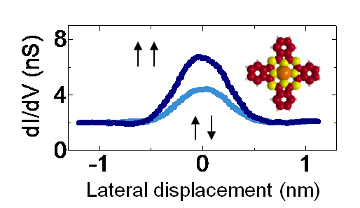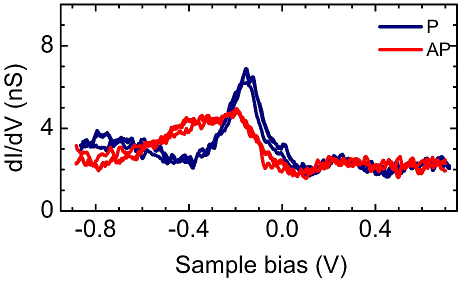In low-temperature, spin-polarized (SP) scanning tunneling microscopy (STM) a magnetic tip generates a spin-polarized tunnelling current that can be used to test the spin state of individual atoms or molecules on a surface. An appealing situation is achieved when a single atom is deposited on a carefully chosen magnetic substrate in order to control and manipulate its spin orientation [1]. The strong exchange coupling creates an imbalance between spin-up and spin-down direction at the atom, leading to slightly different orbital contributions close to the Fermi energy. The magnetic imbalance can then be read by the tunnelling current of a magnetic tip that can distinguish between different spin states.
Depending on its environment an atom can exhibit a variety of magnetic behaviors. To explore this field, we have performed the first SP-STM measurement on a “dressed” metal atom in a phthalocyanine molecule [2]. This work obtained large international recognition and triggered several studies by other groups in renowned journals. In this case, the ligand-field as well as the interaction of the molecule with the surface plays a key role.
To understand this approach, it is important to recall that STM combines both, spatial and energy resolution of the conductance. For example one can ramp the bias voltage V applied between the tip and the sample while simultaneously taking dI/dV’s at different places above the molecule. As is shown in Fig. 1, on the example of Co-phthalocyanine (CoPc) on a non-magnetic substrate, such measurements provide a map of the energy dependent conductance channels which in turn can be linked to orbital signatures.
In order to “visualize” the spin contrast of the d-electrons of the molecule, it is necessary to lock its paramagnetic moment along a well defined direction. For this purpose, the CoPc molecule was exchange-coupled to an underlying cobalt nanoisland (see highlights). The d-electron resonance is now found at a different energy and due to the magnetic coupling, the dI/dV maps over single molecules can now be visualized for different spin orientations as shown in Fig. 2.
Hence, a fascinating conclusion of the SP-dI/dV analysis is that the molecule can act both, as a featureless scattering barrier and as a tunable spin filter, depending on the energy and spatial position probed.
These systems and others are presently under consideration within the SpinMaster project (ANR-Blanc) which is dealing with spin injection and transport through atoms and molecules in the tunneling and contact regime. For this purpose a new, low noise, LT-STM equipped with a superconducting vector magnetic field has been developed in collaboration with Createch, Berlin (see facilities). Although the results described here are of fundamental nature, they provide answers to burning questions in molecular spintronics where ferromagnetic electrodes are used to inject a spin-polarized current across a narrow interface between atoms/molecules and the electrodes.



In collaboration with J. Kortus, Th Brumme, TU-Freiberg and V. Stepanyuk, P. Ignatiev, Max Planck Institut, Halle and W. Hofer, University of Liverpool.
[1] J.P. Bucher, Nature Nanotech. 5, 315 (2010).
[2] C. Iacovita, M.V. Rastei, B. Heinrich, Th. Brumme, J. Kortus, L. Limot, J.P. Bucher, Phys. Rev. Lett. 101, 116602 (2008).
[3] B.W. Heinrich, C. Iacovita, Th. Brumme, D.J. Choi, L. Limot, M.V. Rastei, J. Kortus, W.A. Hofer, J.P. Bucher, J. Phys. Chem. Lett. 1,1517 (2010).
